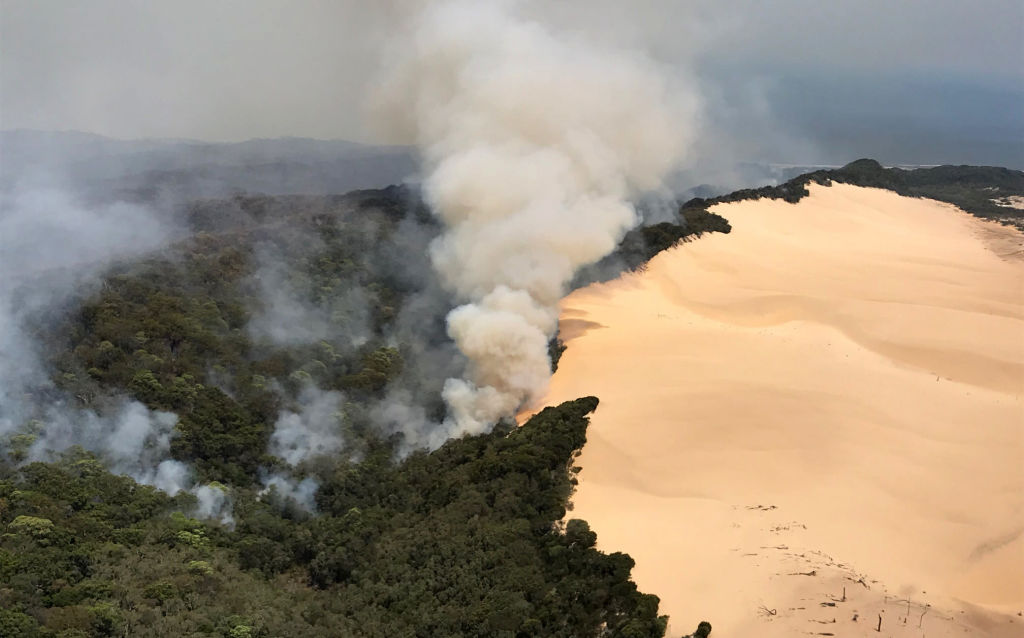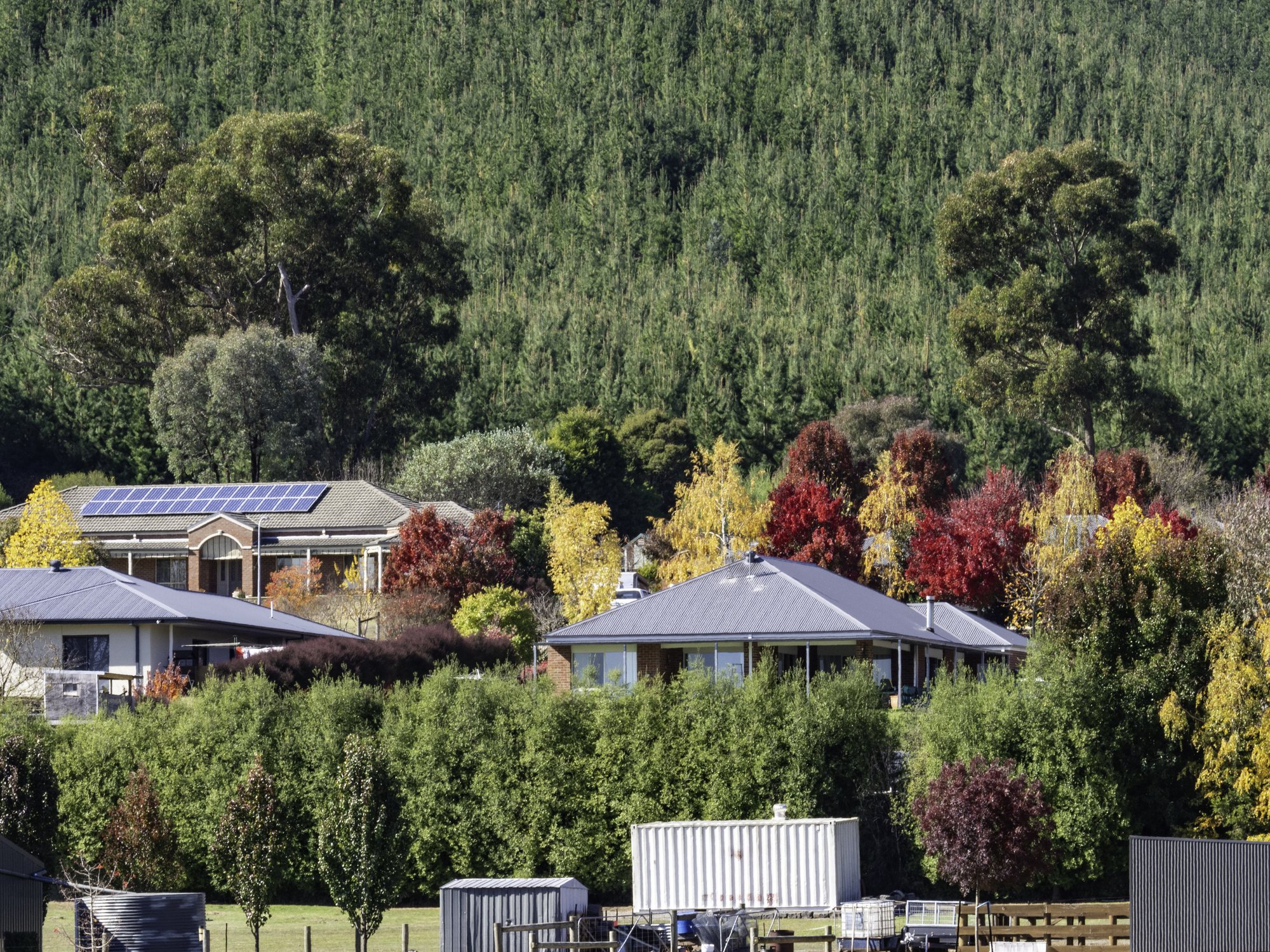Fighting Bushfires Goes High Tech With Laser Drones, Sensors And Satellites
Australia’s fire season looms and researchers are looking to move beyond ‘detecting fires with people in towers and binoculars’.
SYDNEY—In October, a sensor mounted on an 8.5-metre pole in the Australian countryside detected small particles in the air near a timber plantation and sent out an alert.
When plantation staff arrived, they found a small man-made fire that was already under control, but the incident offered a glimpse of how authorities hope to use new technology to battle bushfires that have grown increasingly intense in recent years.
As a new fire season begins in Australia—a recent bushfire ravaged about half of Fraser Island in the country’s east—researchers are looking to rely more on technology to find blazes quickly and better predict their path.
A monthslong government inquiry into the devastating 2019-2020 fire season in Australia, which killed more than two dozen people and burned an area bigger than Washington state, concluded that authorities need to be better prepared and recommended that officials work with the private sector to develop new technology.
“We’re still detecting fires with people in towers and binoculars. We’ve got to move beyond that,” said Leigh Kelson, program director at FireTech Connect in Australia, a government-funded effort to help startups develop new firefighting technologies. Firefighters also rely on the equivalent of 911 calls to find new blazes.
The ideas researchers are exploring include fitting drones with lasers that can map dry areas at higher fire risk and whether satellites can detect extreme fire behaviour.
Last fire season, authorities were surprised by how quickly the blazes spread and how long they burned, which they later attributed to a prolonged drought that had left the land parched with plenty of dry vegetation to fuel the flames. Last year was Australia’s hottest year on record, according to the government’s Bureau of Meteorology, and fires are projected to become more intense and frequent because of climate change.
Parts of Australia have received more rainfall in recent months, and the current fire season isn’t expected to be as severe. Still, firefighters have struggled to control some of the blazes. The fire on Fraser Island, the largest sand island in the world and a Unesco World Heritage site, prompted officials to tell some residents to evacuate from homes in the path of the flames. On Sunday, firefighters said rainfall had finally helped to contain that blaze, which started in mid-October.
Other regions, including the western U.S. and even in frosty Siberia, have experienced particularly intense fire seasons recently, stretching global firefighting resources and making early detection of fires more crucial. Fires left unchecked can create their own weather systems, raining embers down on nearby communities and pushing dangerous smoke into big cities and even to neighbouring countries.
The sensor that picked up the October fire near the timber plantation is one of more than 40 in a network that covers an area nearly double the size of New York City in Australia’s Victoria state. The solar-powered, cylinder-shaped sensors are packed with instruments including optical and thermal cameras, flame detectors, particle counters for air quality, and ground-vibration readers. The data are publicly available online in real-time.
Attentis Pty. Ltd., a Melbourne, Australia-based company, finished installing the network in early 2019 as a pilot project to demonstrate the technology. They didn’t get much use detecting fires last season because the blazes were too far away.
Cameron McKenna, managing director at the company, said he is in talks to install similar sensor networks to improve fire detection capabilities in other parts of the country. “We use multiple methods of detection as opposed to a single method,” he said.
In Canberra, Australia’s capital, researchers are working with a local firefighting agency to install video cameras on four fire towers. One tower will also have a thermal camera installed.
A computer program will scan images from the thermal camera to detect fires, and a person will monitor the other video feeds. Researchers plan to develop a computer program to automatically scan the video feeds too, said Marta Yebra, director of the Australian National University Bushfire Initiative. The idea is to determine whether the cameras detect new fires quicker than the old-fashioned way of having a person in the fire tower, she said.
Rohan Scott, who leads the rural fire service in the Canberra area, said people in towers on average spot fires within seven minutes of ignition. But the towers are only staffed on high-risk days.
“If we can get detection 24/7 but at the same speed as a human-manned fire tower, then I think that would be a good outcome,” he said. “Anything quicker than that would be a definite bonus.”
Other ideas involve using drones fitted with lasers to create detailed maps so authorities know which areas have more dry vegetation and present a higher fire risk. One recent effort involved researchers poring over satellite imagery in an attempt to build a model for detecting extreme fire behaviour from orbit. They found that changes in smoke colours could help predict fire behaviour, according to the Minderoo Foundation, a nonprofit that sponsored the research.
One company, Fireball.International Pty. Ltd., says its machine-learning method can detect smoke from ground-based cameras and fires from heat signatures on thermal-satellite images. Its system is already being used by a big power company in California, and Fireball plans to begin pilot programs in Australia this fire season, executives said.
A prototype of the system detected smoke from fires within 15 minutes of ignition, while averaging less than one false positive a day per camera, according to an analysis published in a peer-reviewed journal in January. It said there is room for improvement.
“People are beginning to realise, ‘Gosh, we really can detect a fire in the first five minutes,’” said Tim Ball, an academic and co-founder of the company who is also a former firefighter.
 Copyright 2020, Dow Jones & Company, Inc. All Rights Reserved Worldwide. LEARN MORE
Copyright 2020, Dow Jones & Company, Inc. All Rights Reserved Worldwide. LEARN MORE
This stylish family home combines a classic palette and finishes with a flexible floorplan
Just 55 minutes from Sydney, make this your creative getaway located in the majestic Hawkesbury region.
As Paris makes its final preparations for the Olympic games, its residents are busy with their own—packing their suitcases, confirming their reservations, and getting out of town.
Worried about the hordes of crowds and overall chaos the Olympics could bring, Parisians are fleeing the city in droves and inundating resort cities around the country. Hotels and holiday rentals in some of France’s most popular vacation destinations—from the French Riviera in the south to the beaches of Normandy in the north—say they are expecting massive crowds this year in advance of the Olympics. The games will run from July 26-Aug. 1.
“It’s already a major holiday season for us, and beyond that, we have the Olympics,” says Stéphane Personeni, general manager of the Lily of the Valley hotel in Saint Tropez. “People began booking early this year.”
Personeni’s hotel typically has no issues filling its rooms each summer—by May of each year, the luxury hotel typically finds itself completely booked out for the months of July and August. But this year, the 53-room hotel began filling up for summer reservations in February.
“We told our regular guests that everything—hotels, apartments, villas—are going to be hard to find this summer,” Personeni says. His neighbours around Saint Tropez say they’re similarly booked up.
As of March, the online marketplace Gens de Confiance (“Trusted People”), saw a 50% increase in reservations from Parisians seeking vacation rentals outside the capital during the Olympics.
Already, August is a popular vacation time for the French. With a minimum of five weeks of vacation mandated by law, many decide to take the entire month off, renting out villas in beachside destinations for longer periods.
But beyond the typical August travel, the Olympics are having a real impact, says Bertille Marchal, a spokesperson for Gens de Confiance.
“We’ve seen nearly three times more reservations for the dates of the Olympics than the following two weeks,” Marchal says. “The increase is definitely linked to the Olympic Games.”

Getty Images
According to the site, the most sought-out vacation destinations are Morbihan and Loire-Atlantique, a seaside region in the northwest; le Var, a coastal area within the southeast of France along the Côte d’Azur; and the island of Corsica in the Mediterranean.
Meanwhile, the Olympics haven’t necessarily been a boon to foreign tourism in the country. Many tourists who might have otherwise come to France are avoiding it this year in favour of other European capitals. In Paris, demand for stays at high-end hotels has collapsed, with bookings down 50% in July compared to last year, according to UMIH Prestige, which represents hotels charging at least €800 ($865) a night for rooms.
Earlier this year, high-end restaurants and concierges said the Olympics might even be an opportunity to score a hard-get-seat at the city’s fine dining.
In the Occitanie region in southwest France, the overall number of reservations this summer hasn’t changed much from last year, says Vincent Gare, president of the regional tourism committee there.
“But looking further at the numbers, we do see an increase in the clientele coming from the Paris region,” Gare told Le Figaro, noting that the increase in reservations has fallen directly on the dates of the Olympic games.
Michel Barré, a retiree living in Paris’s Le Marais neighbourhood, is one of those opting for the beach rather than the opening ceremony. In January, he booked a stay in Normandy for two weeks.
“Even though it’s a major European capital, Paris is still a small city—it’s a massive effort to host all of these events,” Barré says. “The Olympics are going to be a mess.”
More than anything, he just wants some calm after an event-filled summer in Paris, which just before the Olympics experienced the drama of a snap election called by Macron.
“It’s been a hectic summer here,” he says.

AFP via Getty Images
Parisians—Barré included—feel that the city, by over-catering to its tourists, is driving out many residents.
Parts of the Seine—usually one of the most popular summertime hangout spots —have been closed off for weeks as the city installs bleachers and Olympics signage. In certain neighbourhoods, residents will need to scan a QR code with police to access their own apartments. And from the Olympics to Sept. 8, Paris is nearly doubling the price of transit tickets from €2.15 to €4 per ride.
The city’s clear willingness to capitalise on its tourists has motivated some residents to do the same. In March, the number of active Airbnb listings in Paris reached an all-time high as hosts rushed to list their apartments. Listings grew 40% from the same time last year, according to the company.
With their regular clients taking off, Parisian restaurants and merchants are complaining that business is down.
“Are there any Parisians left in Paris?” Alaine Fontaine, president of the restaurant industry association, told the radio station Franceinfo on Sunday. “For the last three weeks, there haven’t been any here.”
Still, for all the talk of those leaving, there are plenty who have decided to stick around.
Jay Swanson, an American expat and YouTuber, can’t imagine leaving during the Olympics—he secured his tickets to see ping pong and volleyball last year. He’s also less concerned about the crowds and road closures than others, having just put together a series of videos explaining how to navigate Paris during the games.
“It’s been 100 years since the Games came to Paris; when else will we get a chance to host the world like this?” Swanson says. “So many Parisians are leaving and tourism is down, so not only will it be quiet but the only people left will be here for a party.”
This stylish family home combines a classic palette and finishes with a flexible floorplan
Just 55 minutes from Sydney, make this your creative getaway located in the majestic Hawkesbury region.






















